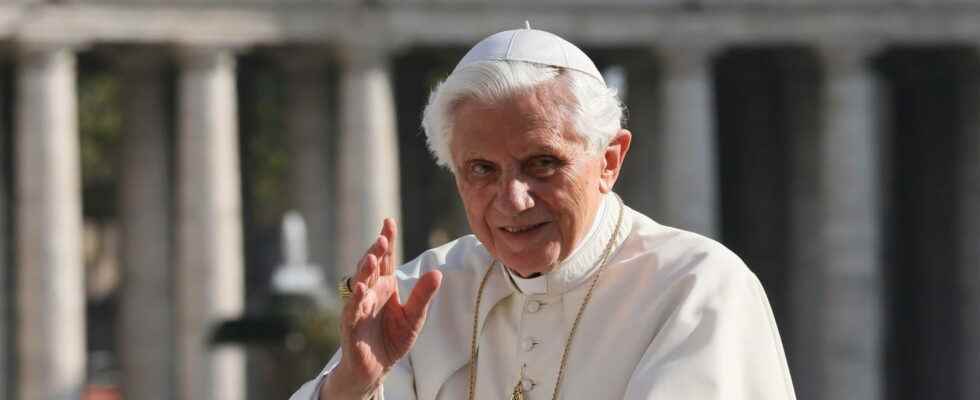BENEDICT XVI. Despite calls to pray from Pope Francis for his predecessor, Benedict XVI died Saturday, December 31 at the age of 95, the Vatican announced.
[Mis à jour le 31 décembre 2022 à 11h10] Calls by Pope Francis to pray for his predecessor will therefore not have been enough. Benedict XVI, Pope Emeritus and predecessor of Pope Francis, died Saturday, December 31, 2022 at the age of 95, the Vatican announced in a communicated. The Holy See specifies that he died at 9:34 a.m., at the Mater Ecclesiae monastery, located in the Vatican. Born as Joseph Ratzinger, he resigned as pope in 2013 due to failing health. But it is especially during these last days that his health deteriorated a lot, leading to his death. Last Wednesday, Pope Francis said, unexpectedly at the end of the general audience, that he wanted to “ask everyone for a special prayer for Pope Emeritus Benedict XVI who, in silence, supports the Church”, specifying that who exercised his right to waiver on February 28, 2013 was “very ill”.
A Vatican source told AFP on Wednesday that Benedict XVI’s health had “deteriorated about three days ago”. And to add: “It is his vital functions that are failing, including the heart.” The Vatican then confirmed that this “worsening in the last hours” of Benedict XVI’s state of health was due to his “advanced age”. Since he had resigned from office in 2013 (read below), Benedict XVI had lived as a recluse in the monastery. He moved only in a wheelchair, had lost (or almost) the use of speech and was equipped with a hearing aid to hear… His appearances were very rare. He had been seen at the end of the summer for the appointment of cardinals. In June 2022, Archbishop Georg Gänswein spoke on the birthday of the former sovereign pontiff. He then spoke of the declining health of Benedict XVI, whose voice was “increasingly weak and incomprehensible”. “The last few years have gotten the better of his strength. But despite his declining strength, he has retained the humble serenity of his heart,” he added, according to Christian family.
Born on April 16, 1927 in Marktl in Bavaria to parents fundamentally opposed to Nazism, he joined the hitler youth in 1941. He thus refused to join the Waffen SS in 1944, and expressed his desire to join the seminary. He was assigned to the Wehrmacht that same year, and deserted shortly before the German surrender. It will be worth to him to be interned during six weeks in a camp of prisoners of war with Aibling. Once released, he began his training as a priest and was ordained on June 29, 1951 by Cardinal von Faulhaber. In 1977, he was appointed cardinal priest of Santa Maria Consolatrice al Tiburtino by Pope Paul VI. A theologian recognized by his peers, he was appointed Prefect of the Congregation for the Doctrine of the Faith, President of the International Theological Commission and of the Pontifical Biblical Commission by the Pope. John Paul II in 1981.
Joseph Ratzinger continued his ascent and became cardinal-bishop in 1993. He entered the College of Cardinals and became its dean in 2002. April 19, 2005, Cardinal Ratzinger is elected to succeed John Paul II, and becomes the first German pope since Victor II, in the 11th century. Known for its conservatism, the pontificate of Benedict XVI marked public opinion with certain positions. He is particularly opposed to the wearing of condoms, homosexuality or abortion. In his Regensburg speech in 2006, he provoked controversy by linking the Muslim religion to violence. But Benedict XVI also distinguished himself for his fight against anti-Semitism and pedophilia in his Church.
After a pontificate of almost eight years, Benedict XVI announced, on February 11, 2013, that he would resign from his functions, which was a first in the history of the Vatican. To justify his resignation, Pope Benedict evokes his fatigue and his vitality which are dwindling with the weight of his office and his many trips. He wears, since the day of his waiver official, on February 28, 2013, the title of “His Holiness Benedict XVI, Roman Pontiff Emeritus”. The pope emeritus has since lived in retirement in the Mater Ecclesiae monastery, located in the gardens of Vatican City. In March 2013, Argentinian Jorge Mario Bergoglio succeeded him under the name of Pope Francis. This new, more open pontificate contrasts considerably with that of Benedict XVI.
Since his renunciation in 2013 at the age of 86, Benedict XVI had made only rare official appearances, during the canonization of the popes John XXIII and John Paul II for example. Despite fragile health, he had continued to receive visits, in particular those from his brother, the priest Georg Ratzinger, as well as those from Pope Francis. On June 28, 2016, a celebration was organized for his 65 years of priesthood. Living in the Vatican, he had made an appearance during the appointment of cardinals at the end of August 2022. On December 29, 2022, his successor, Pope Francis, declared that he was “seriously ill”. Two days later, on December 31, 2022, the Vatican announced his death at the age of 95.
Benedict XVI: key dates
- April 16, 1927: Birth of Joseph Ratzinger, 265th pope under the name of Benedict XVI.
- Joseph Alois Ratzinger was born on April 16, 1927 in Marktl, Bavaria. A former philosophy teacher, this erudite theologian, with an intellectual reputation, became a cardinal in 1997. He was elected pope on April 19, 2005 under the name of Benedict XVI, thus succeeding John Paul II. His pontificate is marked by very traditional positions, notably on homosexuality and the right to abortion. He actively participated in the beatification of his predecessor.
